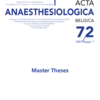A tool to facilitate anesthetic preoperative consultations
Decision support techniques; referral and consultation/organization & administration; pre-operative care/standards; risk assessment; surveys and questionnaires
Published online: Apr 21 2022
Abstract
As surgical procedures have become more complex and are being performed in populations with higher age and increased comorbidities, preoperative anesthesia consultations (PAC) have become part of the standard perioperative management. Technical progress in healthcare could benefit efficiency, and cost-effectiveness of patient care. In our faster, digitalized society, patient- completed electronic questionnaires are gaining interest over their paper analogue. This study aimed to create and evaluate the reliability of a patient-completed electronic preoperative questionnaire incorporated in an instrument (PAC tool) with a built-in risk score calcu- lator. The electronic preoperative questionnaire was created in Airtable, an online spreadsheet database, and its content was constituted combining the content of the existing paper printed preoperative questionnaire of the University Hospital of Ghent and adding questions relevant to risk score calculation. Twenty-one patients of named center were enrolled, the questionnaire was evaluated using inter-rater reliability analysis and the validity of the risk score calculator was assessed for agreement between automatically calculated risk scores and manually calculated risk scores. Excellent criterion validity for the questionnaire was observed in 86% of the questions, fair to good criterion validity in 7%, 1 out of 70 questions didn’t reach criterion validity and 4 out of 70 questions couldn’t be analyzed. Regarding the risk score calculator, agreement in risk scores was obtained for all risk scores included in the analysis. 2 risk scores were left out because of an inadequate number of answers. Given a larger sample size population, the content of this patient-completed electronic questionnaire could prove appropriate for obtaining specific medical history, exercise tolerance and more in the context of preanesthetic consultations. Additionally, the use of the built-in risk score calculator in the PAC tool could prove useful and efficient
